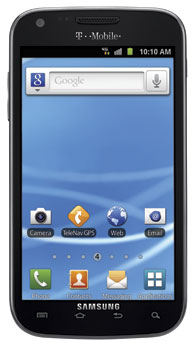
Original Link: https://www.anandtech.com/show/4714/why-i-believe-tmobiles-galaxy-s-ii-uses-a-qualcomm-soc
Why I Believe T-Mobile's Galaxy S II Uses a Qualcomm SoC
by Brian Klug on August 31, 2011 1:19 AM EST- Posted in
- Samsung
- Snapdragon
- Qualcomm
- Smartphones
- Galaxy S II
- Mobile
- T-Mobile

Earlier tonight Samsung announced all three US variants of the Galaxy S II: the Galaxy S II on AT&T, the Galaxy S II Epic 4G Touch on Sprint and the Galaxy S II on T-Mobile. The first two are based on the same 1.2GHz Exynos 4210 SoC that Samsung used in the international version of the Galaxy S II. The T-Mobile version, on the other hand, ships with an unnamed dual-core SoC also running at 1.2GHz. In our story earlier tonight we listed the T-Mobile version as having a Qualcomm SoC. I wanted to clarify my reasoning for suspecting that Qualcomm is inside the third US-bound Galaxy S II.
To begin with, T-Mobile has been very scant on details about their variant, noting only that the device exists and (through Samsung's more general Galaxy S 2 announcement) that it has a 1.2 GHz dual core SoC. Note that there's no direct announcement that the T-Mobile version has or doesn't have an Exynos SoC. Our own Jason I. asked reps as well who declined to comment for or against Exynos. Further, the device was off limits for hands-on, instead housed in a glass case where only the home screen was permitted to be shown. That's certainly one way to raise an eyebrow and draw attention to the fact that one of the three US Galaxy S 2 devices isn't quite like the others. But without much more, it seems circumstantial at best.
So what's the next clue? The next major piece of evidence is that we've been expecting a similarly-specced device for some time now. Back in May, This is my next noted that a top-tier Samsung device would soon arrive on T-Mobile soil with an APQ8060 SoC and MDM8220 baseband. Qualcomm's MDM8220 is a 45nm 3GPP Release 8 DC-HSPA+ HSDPA Category 24 (42 Mbps) modem. APQ8060 is merely an MSM8x60 dual core snapdragon minus the modem.
As a refresher, the DC in DC-HSPA+ stands for dual-carrier (or dual-cell), and effectively means that the air interface supports using the bandwidth of two WCDMA channels, which are 5 MHz wide. Dual-carrier HSPA+ effectively aggregates traffic across two 5 MHz WCDMA channels, resulting in close to a doubling of performance. Recall now that T-Mobile has been upgrading its network to DC-HSPA+ in markets where it has the bandwidth, and no doubt has been looking for a smartphone to rightfully take advantage of it.
The question you should be asking now is why all of that that matters for the SoC choice - shouldn't Samsung be able to pair any modem with any SoC? In almost every circumstance, that's absolutely the case, however what's interesting about MDM8220 is that it isn't natively voice enabled. Instead, MDM8220 (unlike other voice-enabled Qualcomm basebands used in smartphones, like MDM6600 or even MDM8200A) is only voice enabled through "fusion" with a Qualcomm SoC. Like we've seen in the past, most fancy new air interfaces start out being data-focused at first (for dongles or portable hotspots), and then become voice enabled later for use in handsets. MDM8220 is one of those kinds of parts, much like MDM9x00 - designed primarily as a data device baseband, but able to do voice with the right Qualcomm SoC.
With that factored in, it becomes easy to see how and why Samsung would go for an APQ8060 alongside MDM8220 - it really is the only means to a DC-HSPA+ smartphone until the next generation of DC-HSPA+ enabled basebands.







